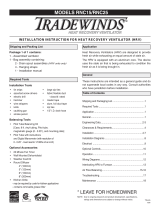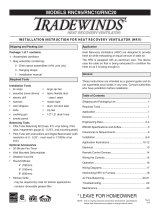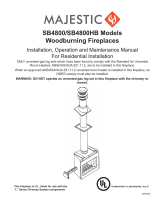Speedi-Products FD-25R6 16 Operating instructions
- Type
- Operating instructions

ADC
Flexible Duct Performance &
Installation Standards
(5
th
Edition)
The “Greenbook” of
Flex
Provides information about –
Characteristics of flexible duct
Testing, Listing, Reporting,
and Certifying
Installation Requirements
Typical Accessories
General Commentary

Flexible Duct Types
(Non-Metallic Ducts)
Insulated –
Non Porous Inner Core
Various types of Outer
Vapor Barriers
Insulated –
Perforated Porous Inner Core
Various types of Outer
Vapor Barriers
Uninsulated

(Metallic Ducts)
Insulated –
Metallic Inner Core
Various types of Outer Vapor Barriers
Uninsulated
Flexible Duct Types

Longitudinal Compression
of Flexible Duct
Compression causes increased pressure
drop:
15% = approximate 2 times
30% = approximate 4 times
45% = approximate 6 to 8 times
The moral of the story:
Ducts should be fully extended before
and during installation.
System has optimum air flow
- Minimizes pressure drop
- Maximizes savings

Goals:
1. Make it easy for the air to change direction.
2. Reduce overall “equivalent feet” of the duct run.
Key Point #4
• Keep bends greater
than or equal to one
(1) duct diameter.
Minimize sagging and
“snaking” of the duct
runs.

90° = 20 equiv. ft.
180° offset = 40 equiv. ft.
45° = 10 equiv. ft.
So how do bends actually affect the air flow?

Examples
If duct is 8 feet long then the total
equivalent length = 28 feet.
For this installation the total
equivalent length is nearly
twice at approximately 50 feet.
Entrance & exit losses intentionally ignored for this
demonstration.

The total pressure drop for any duct run equals the sum of the fitting (or
bend) pressure drops and the pressure drop of the straight duct section.
Entrance fitting = 35 ft.
Total duct length = 14 ft.
2 x 45° bends (2 x 10’) = 20 ft.
1 x 90° bend (1 x 20’) = 20 ft.
Exit fitting = 35 ft.
Total Equivalent Length = 124 ft.

Proper Flexible Duct Connections
• Sleeves used to connect 2 flex duct pieces
together shall be a minimum of 4 inches
in length and beaded on each end.
• For non-metallic ducts, fittings shall be
beaded and have a minimum of 2 inches
collar length.
• Use tapes or mastics listed to the UL181B Standard and marked “UL181B-
FX” for tape and “UL181B-M” for mastic.
• If non-metallic straps are used, the straps should be listed to the UL181B
Standard and marked “UL181B-C”. Maximum pressure is limited to 6 inches
W.C. with non-metallic straps.

or
The
right
way to get
from here to there!!!!!!!

Using tape and fasteners to make connection
• Cut completely through duct and wire
• Fold back vapor barrier and insulation
• Slide 1” of core over fitting and bead
• Seal core to collar with 2 wraps of duct
tape
• Secure connection with clamp placed
over the core and tape, past the bead
• Pull vapor barrier and insulation back
over the core
• Tape barrier with 2 wraps of duct tape
Flexible Duct Connection
(Non-Metallic)

Using tape and fasteners to make splice
Flexible Duct Splice
(Non-Metallic)
• Cut completely through duct and wire
• Fold back vapor barrier and insulation on
both ends
• Slide 1” of each core over connecting
collar and beads
• Seal cores to collar with 2 wraps of duct
tape
• Secure each connection with clamp
placed over the core and tape, past the
bead
• Pull vapor barrier and insulation back
over the core and overlap
• Tape barrier with 2 wraps of duct tape

Flexible Duct Connection
(Non-Metallic)
• Cut completely through duct and wire
• Fold back vapor barrier and insulation
• Apply mastic uniformly to the outside
surface of collar
• Slide 1” of core over collar and past the
bead
• Secure connection with clamp placed
over the core and past the bead
• Pull vapor barrier and insulation back
over the core and fitting
• Tape barrier with 2 wraps of duct tape
Using mastic and fasteners to make connection

Flexible Duct Splice
(Non-Metallic)
• Cut completely through duct and wire
• Fold back vapor barrier and insulation
on both ends
• Apply mastic uniformly to both ends of
the connecting collar
• Slide 1” of each core over connecting
collar and beads
• Secure each connection with clamp
placed over the core, past the beads
• Pull vapor barrier and insulation back
over the core and overlap
• Tape barrier with 2 wraps of duct tape
Using mastic and fasteners to make splice

Using tape or mastic and screws to make a connection
Flexible Duct Connection
(Metallic)
• Cut completely through duct and trim
edge
• Fold back vapor barrier and insulation
• When using mastic, apply uniformly to
collar
• Slide 1” of core over fitting
• Secure connection with #8 sheet metal
screws spaced equally around
circumference. Use 3 screws for
diameters under 12” and 5 for diameters
12” and over
• When using tape (press. < 4”), seal core
to collar with 2 wraps of duct tape
• Pull vapor barrier and insulation back
over the core
• Tape barrier with 2 wraps of duct tape

Using tape or mastic and sheet metal screws to make splice
Flexible Duct Splice
(Metallic)
• Cut completely through duct and trim
edge
• Fold back vapor barrier and insulation
on both ends
• When using mastic, apply uniformly
both ends of the connecting collar
• Slide 1” of core over connecting collar
• Secure cores with #8 sheet metal screws
spaced equally around circumference.
Use 3 screws for diameters under 12”
and 5 for diameters 12” and over
• When using tape (press. <4”), seal cores
together with 2 wraps of duct tape
• Pull vapor barrier and insulation back
over the cores and overlap
• Tape barrier with 2 wraps of duct tape

What material should I use to support flexible duct?
Per NFPA 90A and 90B, supplementary material used with air ducts shall meet
the requirements of Class 1 when tested to UL 723 (Surface Burn
Characteristic Testing), i.e. 25 Flame Spread & 50 smoke developed maximum.
Per ADC, any strapping material in contact with the flexible duct shall be 1-1/2
inch wide minimum and be applied at intervals not to exceed 4 feet (6 feet for
vertical supports). Sag should not exceed ½ inch per foot of support spacing.

Additional Points on Supporting Flex Duct
Ceiling joists or truss
supports used to support
flexible duct
Added supports before and after tight bends Added support to avoid damage by fitting
-
 1
1
-
 2
2
-
 3
3
-
 4
4
-
 5
5
-
 6
6
-
 7
7
-
 8
8
-
 9
9
-
 10
10
-
 11
11
-
 12
12
-
 13
13
-
 14
14
-
 15
15
-
 16
16
-
 17
17
-
 18
18
Speedi-Products FD-25R6 16 Operating instructions
- Type
- Operating instructions
Ask a question and I''ll find the answer in the document
Finding information in a document is now easier with AI
Other documents
-
Quietflex Manufacturing SS0580 Installation guide
-
Thermaflex 0579-0600-0001 Installation guide
-
Flexible Technologies 0579-0600-0001 Installation guide
-
 Tradewins Furniture RNC15 User manual
Tradewins Furniture RNC15 User manual
-
 Tradewinds RNC95 User manual
Tradewinds RNC95 User manual
-
 Tradewins Furniture RNC5-TPF User manual
Tradewins Furniture RNC5-TPF User manual
-
FIELD CONTROLS HRV / ERV Models FC150HRV/ERV & FC200HRV/ERV Installation guide
-
Monessen Hearth BWBC400 User manual
-
Monessen Hearth 624WBPF User manual
-
 Martin Fireplaces SB4800 Installation, Operation And Maintenance Manual For Residential Installation
Martin Fireplaces SB4800 Installation, Operation And Maintenance Manual For Residential Installation





















